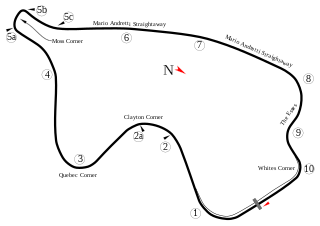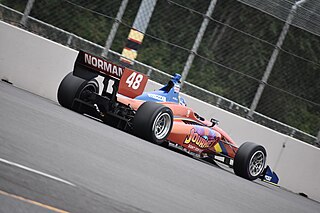
Canadian Tire Motorsport Park is a multi-track motorsport venue located north of Bowmanville, in Ontario, Canada, 64-kilometre (40 mi) east of Toronto. The facility features a 3.957 km (2.459 mi), 10-turn road course; a 2.9 km (1.8 mi) advance driver and race driver training facility with a 0.402 km (0.250 mi) skid pad and a 1.5 km (0.93 mi) kart track. The name "Mosport", a portmanteau of Motor Sport, came from the enterprise formed to build the track.
The International Motor Sports Association (IMSA) is a North American sports car racing sanctioning body based in Daytona Beach, Florida under the jurisdiction of the ACCUS arm of the FIA. It was started by John Bishop, a former executive director of SCCA, and his wife Peggy in 1969 with help from Bill France Sr. of NASCAR. Beginning in 2014, IMSA is the sanctioning body of the WeatherTech SportsCar Championship, the premier series resulting from the merger of Grand-Am Road Racing and the American Le Mans Series. IMSA is owned by NASCAR, as a division of the company.
The Atlantic Championship is a formula race car series with races throughout North America. It has been called Champ Car Atlantics, Toyota Atlantics, or just Atlantics or Formula Atlantic, although the latter two terms risk confusion with the Sports Car Club of America's amateur Formula Atlantics division.

Formula Ford, also known as F1600 and Formula F, is an entry-level class of single seater, open-wheel formula racing. The various championships held across the world form an important step for many prospective Formula One drivers. Formula Ford has traditionally been regarded as the first major stepping stone into formula racing after karting. The series typically sees career-minded drivers enter alongside amateurs and enthusiasts. Success in Formula Ford can lead directly to other junior formula series such as a Formula Renault 2.0 and Formula Three, or the W Series for female drivers.

Formula Atlantic is a specification of open-wheel racing car developed in the 1970s. It was used in professional racing through the IMSA Atlantic Championship until 2009 and is currently primarily used in amateur racing through Sports Car Club of America Formula Atlantic.

Tom Bagley, is a former driver in the USAC, CART Championship Car, IMSA, Formula Atlantic, and Trans-Am Series. He raced Indycars in the 1978-1980 and 1983 seasons, with 42 combined career starts, including the 1978-1980 Indianapolis 500, finishing in the top ten 23 times, with a best finish, three times, of 4th position. He was USAC Rookie of the Year in 1978, and did not finish worse than 11th in points during his three full-time seasons. He did not begin wheel-to-wheel racing until age 31, after earning a master's degree in Physics from Pennsylvania State University. While in college, Bagley became interested in fuel mileage competitions and then autocross, rising to the attention of Bill Scott, operator of the racing school at Summit Point Motorsports Park. Scott lent Bagley a Formula Ford car to begin his career. Bagley and Janet Guthrie were the only physicists to compete in Indycar in the 1970s. Bagley rose to fame driving Formula Super Vee cars, winning the SCCA championship in 1976, and was USAC co-champion in 1977. Bagley owned and maintained his own race cars in this part of his career. He next joined the Indycar ranks with sponsorship from Kent Oil, driving for Longhorn Racing and Patrick Racing. After retiring from racing full-time, Bagley worked as a physicist for longtime series sponsor PPG Industries, developing new methods for creating powder paints. From 2004 to 2020 he worked at Autobahn Country Club as the Director of Racing Instruction, responsible for designing the safety features at the track and overseeing the instruction, licensing, and racing activities. Bagley still competes in club and endurance races in his Spec Miata and vintage events including the Indy Legends Charity Pro–Am race on occasion. Bagley was described by the SVRA in 2019 as a "driver who accomplished much with limited resources" and "the driver to beat in Formula Super Vee"
Elliott Forbes-Robinson is a road racing race car driver. He is known for his race wins and championships in many different series, including the American Le Mans Series (ALMS), Super Vee, Trans-Am Series, CanAm, IMSA GTU, and the World Challenge. He is known in NASCAR circles as a road course ringer. He is also a founder of the Legends Cars of 600 Racing and he designed their original car.

Formula Super Vee was an open-wheel racing series that took place in Europe and the United States from 1970 to 1990. The formula was created as an extension of Formula Vee, a racing class that was introduced in 1959. Formula Super Vee in Europe was similar to F3 or Formula Renault today, a stepping stone to F1. In the United States, Formula Super Vee, often referred to as Super Vee, was a natural progression to Indy Car and Can-Am. On both sides of the Atlantic the series also was a platform for the promotion of VW products, similar to how Formula Renault promotes Renault products today.

The USF2000 Championship Presented by Cooper Tires is an American racing series using the American variation of the Formula Ford formula, "F2000", that resumed operation for the 2010 season. As of 2022, it is sanctioned by the United States Auto Club, and is the second rung of the Road to Indy.

Formula Enterprises or Formula SCCA is a class of open wheel race car sanctioned by the Sports Car Club of America. A spec racing class, all chassis are produced by SCCA Enterprises in association with Van Diemen and include a sealed Mazda MZR powerplant. The chassis can also be fitted with closed-wheel bodywork and converted into a sportscar to race in C Sports Racer or the L3 class of IMSA Prototype Lites. For the 2012 season, the car was also accepted into the U.S. F2000 National Championship's National Class. According to the manufacturer's website, as of March 2010, 120 of the cars have been sold.
SCCA Pro Racing is the pro racing division of the Sports Car Club of America. SCCA Pro Racing was formed in 1963, the company is a fully owned subsidiary of SCCA.
Royale Race Cars was a British constructor of race cars in the 20th century. The company produced single seaters as well as sports cars.

Nelson Mason is a Canadian racing driver currently racing in the World Series Formula V8 3.5 for Teo Martín Motorsport. He is one of only a handful of Canadian racing drivers who made the step into the European motorsport scene with some success. He added the 2013 European F3 Open Winter Series Championship to his crown and made the move up into World Series this year.
Zink Cars is a former constructor of Formula Vee cars among other racing cars. Zink Cars was formed in 1962, as of 1974 all manufacturing of the Zink racing cars was taken over by Citation Engineering.
The 1974 SCCA Formula Super Vee season was the fourth season of the Sports Car Club of America sanctioned Formula Super Vee championship. This season marked the first season of the second generation of the Formula Super Vee. One of the innovations was the introduction of slick tyres. As of 1974 not all of the series races were sanctioned by the SCCA, seven rounds were sanctioned by the International Motor Sports Association.

Ryan Norman is an American racing driver. Norman is a former motocross rider and is currently competing in the Michelin Pilot Challenge, driving for Bryan Herta Autosport and won the 2020 IMSA TCR Championship for the team. He formerly drove for Andretti Autosport in Indy Lights with multiple wins and podiums, and ran a race in the IndyCar Series in 2021 with Dale Coyne Racing.
Flinn Lazier is an American racing driver. Lazier has raced in Formula Vee, Formula Enterprise, Formula Atlantic, Formula 4, and USF2000. Lazier was also a competitive skier with the Ski & Snowboard Club Vail.
Curtis Farley is a former racing driver and SCCA National Championship Runoffs winner.
Autodynamics Inc. is a former American racecar manufacturer based in Marblehead, Massachusetts. The company mainly produced Formula Vee and Formula Ford chassis. The company was also active in the Trans-Am Series entering Dodge Challengers in the 1970 season.

Stuart Crow is an American former racing driver. Crow won the 1990 United States Formula Super Vee Championship and the 2000 United States Formula 3 Championship.









